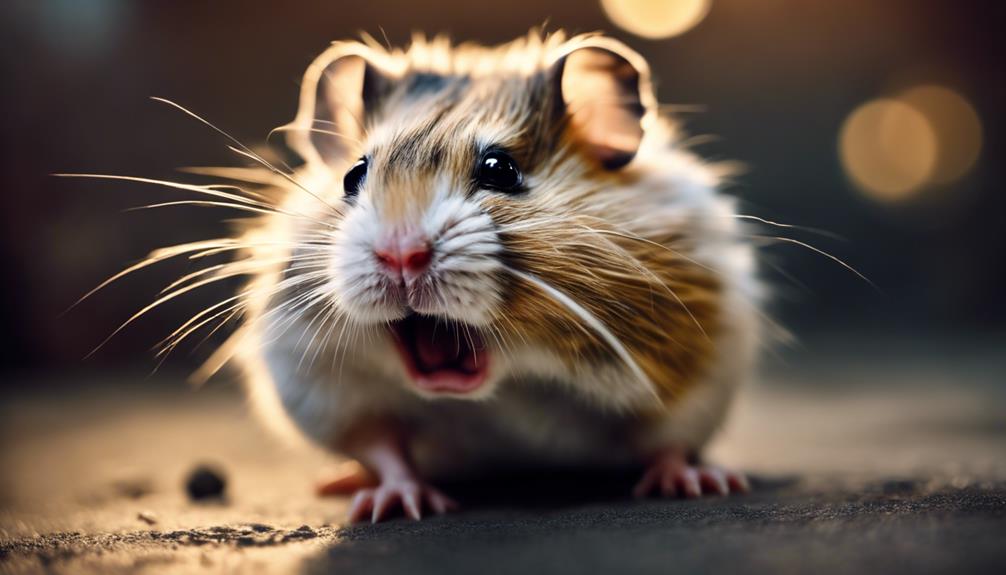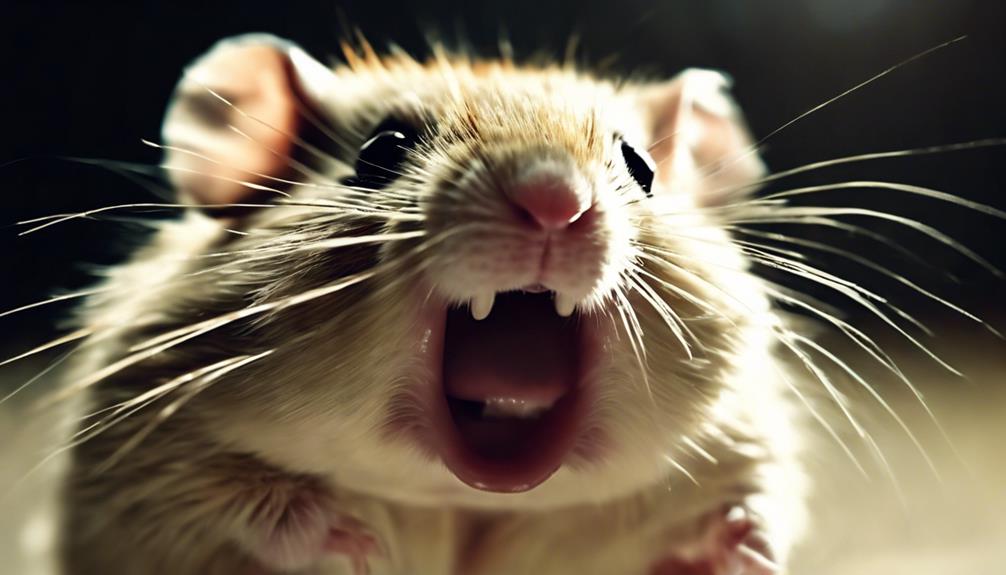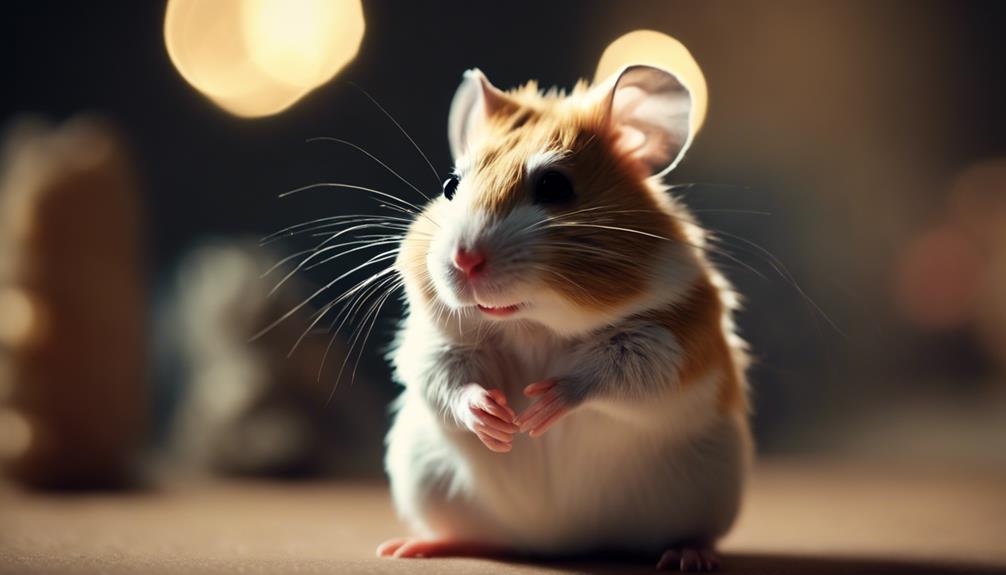Do Hamsters Have Unique Vocalizations? What Sounds They Make and Why

Hamsters have unique vocalizations that convey emotions and needs, from soft chirps to loud hisses.
Understanding these sounds can provide insights into a hamster's well-being and state of mind.
Types of Hamster Vocalizations
Hamsters frequently communicate through various vocalizations that convey different meanings. Vocalization patterns are crucial in understanding a hamster's mood and needs.
These small creatures use a combination of sounds to express themselves, ranging from soft chirps to loud squeaks. Each sound carries unique information, allowing attentive owners to decipher their pets' emotions.
Sound interpretations play a significant role in hamster care, enabling individuals to respond appropriately to their furry companions.
Squeaks: What Do They Mean?
Hamster squeaks serve as a vital form of communication among these small creatures. These high-pitched sounds are often used by hamsters to seek attention from their owners or to express excitement during playtime.
Understanding the nuances of hamster squeaks can deepen the bond between pet and owner.
Squeaks as Communication
When emitting squeaks, these small rodents convey a wide range of messages to their fellow hamsters and attentive human companions alike. Squeaks can serve as bonding behavior, strengthening social connections within a hamster community. They can also act as stress indicators, signaling discomfort or anxiety in response to various stimuli. To better understand the nuanced meanings behind hamster squeaks, refer to the table below:
| Squeak Type | Meaning |
|---|---|
| Bonding Squeaks | Expressing affection and camaraderie |
| Stress Squeaks | Signaling fear, discomfort, or unease |
| Playful Squeaks | Indicating excitement and enjoyment |
| Warning Squeaks | Alerting others of potential danger or threat |
| Investigative Squeaks | Curiosity or exploration |
Squeaks for Attention
In the realm of hamster communication, squeaks serve as a compelling vocal tool to express their need for attention and interaction. Hamsters emit high-pitched squeaks when they seek engagement with their human companions. These vocalizations, combined with subtle body language cues like standing on hind legs or approaching the cage bars, are ways for hamsters to communicate their desire for interaction.
Responding to these squeaks promptly can strengthen the bond between hamster and owner, fostering a sense of trust and companionship. Understanding the significance of these vocalizations and accompanying body language is crucial for creating a harmonious relationship with these small, endearing pets.
Hamsters use their squeaks not just for attention, but as a means of building a connection through mutual understanding and interaction.
Squeaks During Playtime
During playtime, hamsters' squeaks serve as a form of joyful expression, conveying their excitement and engagement in the interactive session. These high-pitched sounds are closely linked to their movements during playtime interactions.
When a hamster is actively exploring, running on their wheel, or interacting with toys, their squeaks often accompany these movements, indicating a positive response to the stimulating environment. The combination of squeaks and movement creates a dynamic communication channel between the hamster and their surroundings, reflecting their playful mood and enjoyment.
Understanding these vocalizations can deepen the bond between pet owners and their hamsters, allowing for a more enriching and interactive playtime experience. So, next time you hear your hamster squeaking during playtime, know that it's a sign of their happiness and contentment.
Chirps and Chatters
Hamsters utilize chirps and chatters as part of their communication repertoire, conveying various messages and emotions through these distinct vocalizations. Understanding the meaning behind these sounds sheds light on hamsters' social interactions within their habitats.
Communication Through Sound
Engaging in chirps and chatters, hamsters effectively convey their emotions and intentions through vocalizations. These sounds serve as an essential form of nonverbal communication, complementing their body language during bonding activities and playtime interactions.
The chirps typically denote excitement, curiosity, or contentment, while chatters often signify agitation or annoyance. By interpreting these vocal cues alongside the hamster's posture and movements, owners can better understand their furry companions' needs and moods.
Creating a harmonious environment where hamsters feel heard and acknowledged enhances the bond between pet and human. Through active listening and observation of their vocalizations, individuals can cultivate a deeper connection with these small but expressive creatures.
Social Interactions Explained
In understanding hamster social interactions through their chirps and chatters, owners gain valuable insights into their furry companions' emotions and intentions. Vocalization frequency plays a crucial role in deciphering the intricate social dynamics within hamster groups.
Hamsters use chirps and chatters to establish hierarchies, express dominance, or signal submission. These vocalizations aren't random; they serve as behavioral cues that provide important information about the hamsters' communication patterns.
Owners who pay attention to the nuances of these sounds can better understand their pets' moods and needs. By interpreting these social interactions, individuals can create a more enriching environment for their hamsters, fostering stronger bonds and promoting positive well-being among these small, but expressive creatures.
Hisses and Growls Explained

The low, rumbling growls emitted by hamsters indicate a range of emotions and intentions. These vocalizations, along with hisses, play a crucial role in hamster communication and can provide valuable insights into their state of mind.
Here are three key points to help you understand hisses and growls in hamsters:
- Aggression: When a hamster feels threatened or territorial, it may emit sharp hisses or low growls to warn off perceived intruders. These sounds serve as a clear indication of the hamster's defensive stance and can help prevent conflicts.
- Fear: In response to a perceived danger or stressful situation, hamsters may produce high-pitched hisses or intense growls to express their fear and discomfort. Understanding these vocal cues can help you provide a secure and reassuring environment for your pet.
- Communication: Hisses and growls are also used by hamsters to establish boundaries, assert dominance, or communicate discomfort. By paying attention to these vocalizations, you can better interpret your hamster's feelings and respond appropriately to their needs.
Purring: The Sound of Contentment
With a gentle hum, hamsters convey their deep contentment through purring. These soft, rhythmic purrs are a clear indication of relaxation and happiness in these small, delightful creatures. When a hamster purrs, it's a moment of pure bliss, a form of communication that speaks volumes without the need for words. As they emit these comforting sounds, it's as if they're sharing their inner peace with those around them.
The act of purring is a powerful way for hamsters to express their contentment, creating a sense of tranquility in their environment. It's a soothing melody that resonates with anyone fortunate enough to hear it, a reminder of the simple joys that can be found in the company of these gentle animals. Through their purrs, hamsters forge connections with those who care for them, establishing a bond built on mutual understanding and comfort.
Whistling and Wheezing Sounds

Emitting subtle whistling and wheezing sounds, hamsters convey a range of emotions and signals that are integral to their communication repertoire. These vocalizations are essential for understanding the well-being and feelings of these small rodents.
Here are three intriguing aspects of hamster whistling behavior and wheezing noises:
- Emotional Expression: Hamsters often emit whistling sounds when they're excited or happy. These noises can indicate contentment or pleasure, providing valuable insight into their emotional state.
- Warning Signals: Wheezing noises are sometimes a sign of distress or discomfort in hamsters. When feeling threatened or unwell, they may produce these sounds to communicate their need for help or to express unease.
- Social Interaction: Whistling sounds can also be a way for hamsters to communicate with each other during social interactions. These soft noises can help establish bonds between hamsters and convey messages within their group dynamic.
Understanding these whistling and wheezing sounds is crucial for interpreting a hamster's inner world and promoting their well-being.
Understanding Teeth Chattering
Hamsters often express various emotions and signals through teeth chattering, a behavior integral to their communication repertoire. Understanding aggression, teeth chattering can indicate a hamster feeling threatened, scared, or anxious. This audible display of aggression serves as a warning to potential threats, signaling that the hamster isn't at ease in its environment. It's crucial for hamster owners to recognize this behavior and assess the situation to ensure the hamster's well-being.
Moreover, dental health plays a significant role in teeth chattering. Hamsters have teeth that continuously grow, and chattering can help them maintain dental hygiene. The grinding motion involved in teeth chattering aids in wearing down their teeth, preventing overgrowth that can lead to health issues. Observing a hamster's teeth chattering can provide insights into its overall health and well-being, making it essential for owners to pay attention to this behavior. By understanding the reasons behind teeth chattering, hamster owners can better care for and communicate with their furry companions.
Communication With Humans

Communication between hamsters and humans can be a fascinating and rewarding aspect of pet ownership. Understanding how hamsters communicate can deepen the bond between pet and owner. Here are three key points to consider:
- Training Techniques: Hamsters are intelligent animals that can be trained to respond to cues and commands. Positive reinforcement methods, such as using treats, can be effective in teaching hamsters tricks or behaviors. This training not only enhances communication but also strengthens the bond between the hamster and its owner.
- Vocalization Interpretation: Paying attention to the various sounds hamsters make can provide insights into their mood and needs. By familiarizing oneself with the different vocalizations, such as squeaks, chirps, or even hisses, owners can better understand and interact with their furry companions.
- Interaction: Regular interaction with your hamster, such as gentle handling and playtime outside the cage, can promote trust and companionship. Engaging in activities that your hamster enjoys, like providing toys for enrichment or creating a safe exploration space, can improve communication and nurture a strong relationship.
Frequently Asked Questions
Do Hamsters Use Their Vocalizations to Communicate With Other Animals Besides Humans?
Hamsters utilize their vocalizations to communicate with a variety of animals beyond humans. Through intricate vocalization patterns, they establish connections with other species, showcasing the complexity and adaptability of animal communication in interspecies interactions.
Can the Pitch or Volume of a Hamster's Vocalizations Indicate Their Mood or Emotions?
Pitch variations in a hamster's vocalizations can offer emotional cues, while volume levels may serve as mood indicators. These subtle distinctions allow these small creatures to communicate their feelings and needs effectively to their caregivers.
Are There Any Specific Vocalizations That Hamsters Use Exclusively During Mating or Courtship Rituals?
Hamsters engage in specific vocalizations during mating behaviors and courtship rituals. These sounds are exclusive to these intimate moments, serving as a means of communication and connection between potential partners in the animal kingdom.
Do Different Species or Breeds of Hamsters Have Unique Vocalizations That Set Them Apart From One Another?
Hamsters, known for their various vocalizations, display unique sounds based on breed differences. These variations serve as a means of communication with other species and enhance their social interactions. Observing these vocal nuances can provide insight into hamster behavior.
How Do Hamsters' Vocalizations Change as They Age, From Young Pups to Older Adults?
As hamsters age, their vocalization development mirrors their growth. Initially, young pups produce softer, more playful sounds during socialization. As older adults, they enhance their communication skills, emitting varied sounds to convey needs and emotions effectively.









